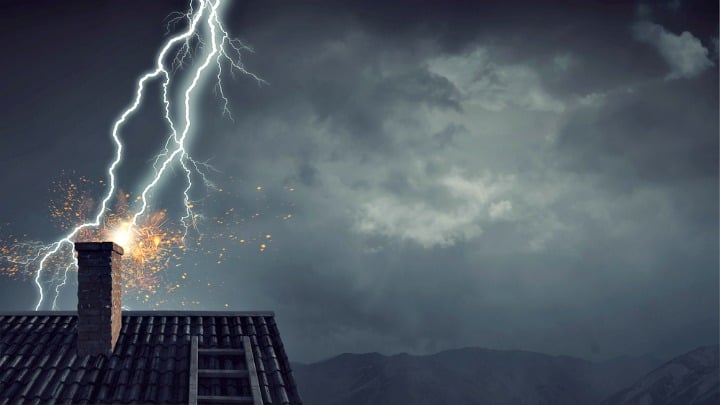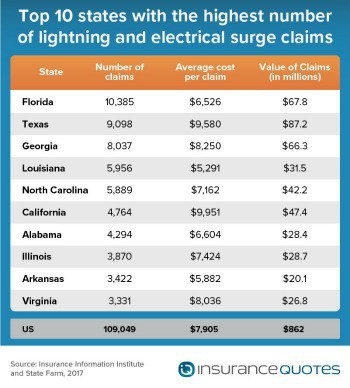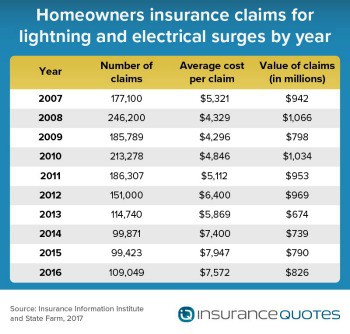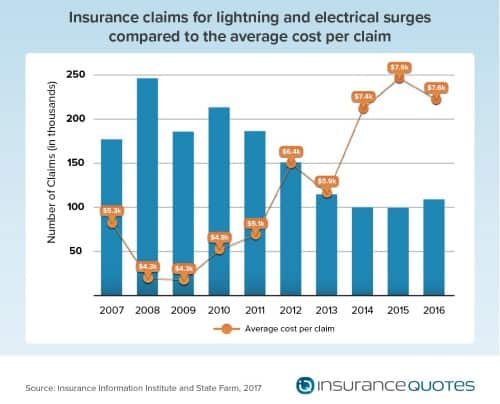Study: Lightning-Related Insurance Claims Up Slightly in 2016 as Payout Amounts Dip

Getting struck by lightning is rare — but when it happens to you or your property, the stakes can be high. In fact, the National Lightning Safety Institute estimates that on average, 1 in 200 houses in the United States will be struck each year.
Those odds, of course, can dramatically increase based on where you live. Florida — thanks to its high heat levels and location between the Atlantic Ocean and Gulf of Mexico — is the nation’s top state for lighting.
But lightning can strike anywhere.
“If you can hear even a rumble of thunder, you’re in danger,” says John Jensenius, a lightning safety specialist with the National Oceanic and Atmospheric Administration.
Of course, seeking shelter for yourself is one thing. Your house doesn’t have that option, which is why homeowners insurance is essential for protection during severe weather. In fact, lightning-related insurance claims are on the rise.
A 2017 study conducted by New York-based Insurance Information Institute in conjunction with State Farm found that homeowners insurance claims from lightning strikes and electrical surges in the United States increased in number from 2015 to 2016, while the average cost per claim decreased.
That may sound encouraging when comparing 2016 to 2015, but actually payouts, for the most part, have been surging since 2011. You can think all your electronic devices for the added dollar amounts.
“The average cost per claim is volatile from year to year,” says the institute’s chief actuary Jim Lynch, “but it has generally continued to rise, in part because of the enormous increase in the number and value of consumer electronics, including increasingly popular home automation systems.”

Other key findings from the 2017 study include:
- More than $825 million in lightning claims was paid out to more than 100,000 policyholders in 2016.
- Total insured losses caused by lightning rose albeit at a slower rate from 2015 to 2016 (4.5 percent) than in the previous two years (12.4 percent overall decrease since 2007).
- Number of claims rose by 9.7 percent from 99,423 in 2015 to 109,049 in 2016
- Average cost per claim was down 4.7 percent despite a steady upward trend since 2007 (42.3 percent).
- More than half of claims involved electrical surge damaging components or wiring; power surges from transformer or service line shorts were also contributing factors.
The study also found that Florida had the greatest number of lightning strikes (no surprise there) with 10,385 paid claims followed by Texas (9,098) and Georgia (8,037).
However, despite its highest ranking for number of paid claims, Florida’s average cost per claim was the third lowest among the ten states at $6,526.
California led the pack with the highest cost per claim ($9,951) followed closely by Texas ($9,580).
The study found Texas to have the highest insured losses ($87.2 million).
How to prevent lightning-related damage
With regards to the study’s finding that more than half of paid claims involved damage to electrical equipment, experts say there are measures homeowners can take to lower the number of claims.
Richard Kithil, founder and CEO at National Lightning Safety Institute, says unplugging all electronics from wall outlets is a good defense, but not practical in many instances.
“TVs, stereos and related home entertainment devices are vulnerable to both direct and indirect lightning strikes,” Kithil says. “The only defense in these instances are Surge Protection Devices (SPDs), typically available to homeowners at ‘big box’ stores.”
 Kithil adds that these SPDs are rated at levels of “joules” or watt-seconds protection, and a joules level of at least 3500J is suggested.
Kithil adds that these SPDs are rated at levels of “joules” or watt-seconds protection, and a joules level of at least 3500J is suggested.
Kithil also recommends installing SPDs in between electrical wall outlets and the equipment to be protected, adding that the cost is small when compared with loss of a computer or large wide-screen TV.
Insurance claims related to lightning
Homeowners insurance does cover damage from most types of lightning strikes. Lightning that causes fires, damages devices and appliances, and injures people are covered as perils under most homeowners insurance policies.
Also included in most homeowners insurance policies is coverage for damage to personal property and additional living expenses.
Damage caused by lightning strkes can be tricky and take a little more investigation by the homeowner because non-structural damage may not be instantly visible.
“About 50 percent of the damage that I see in homes hit by lightning is from an electrical surge that comes in on the communication lines,” says project manager Berwick Project Terry Schnieder with Berwick Electric in Colorado. “I would recommend that people install surge protection devices on phone lines, satellite antennae, and phone lines.”
Homeowners need to be diligent about checking their electrical equipment and appliances after a lightning storm. Be sure to document all your losses.

The insurance adjuster most likely will inspect the damage to your home, auto and possessions in order to write a check to help you replace, repair and rebuild.
It is a good idea to take photographs and document the details of damaged items, including the date of purchase and approximate value — and collect receipts, if you have them.
Many companies will ask you to submit an inventory of the items.
Also, III reminds people to always check with your insurere before discarding damaged material because you may need to show items, even small electronic ones, to your adjuster.
If, however, you are required by your local municipality to discard them for safety reasons, take photographs to help with the claims process.
